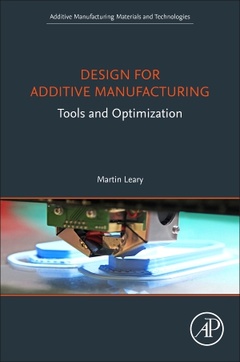Description
Design for Additive Manufacturing
Tools and Optimization
Additive Manufacturing Materials and Technologies Series
Author: Leary Martin
Language: English
Subject for Design for Additive Manufacturing:
Keywords
3D printing; 3MF; Additive Manufacturing (AM)DFAM; Aerospace; AM process selection; BC2AM; Binder jetting (MJT)Biomaterials; Biofouling; Bioplotting; Ceramics; Certification; Commercial best practice; DED; Detail DFAM; DFAM; Digital DFAM; Dilution; Directed energy deposition; DLP; Dosimetry phantoms; Dosimetry; Electron beam melting; Engineering design; Engineering economics; Exhaustive search; Expert system; Failure-modes; Fatigue; Functional gradient; GD&T; Generative design (GD)DFAM; Generative design; Generative DFAM; Gibson-Ashby; Gyroid; Impact; Innovation management; Inside-out design; Laser additive manufacturing; Lattice; Lightweight structures; Margin cost; Market pull; Mass-customization; Material extrusion (MEX)Net-shape; Material Jetting (MJT)Rapid prototyping; Maxwell; Metals; Net-shape manufacture; Optimization; Paradox of engineering design; Parametric optimization; Patient-specific medical implants; Patient-specific; PBF; Polymers
358 p. · 15x22.8 cm · Paperback
Description
/li>Contents
/li>Readership
/li>Biography
/li>Comment
/li>
Design for Additive Manufacturing is a complete guide to design tools for the manufacturing requirements of AM and how they can enable the optimization of process and product parameters for the reduction of manufacturing costs and effort. This timely synopsis of state-of-the-art design tools for AM brings the reader right up-to-date on the latest methods from both academia and industry. Tools for both metallic and polymeric AM technologies are presented and critically reviewed, along with their manufacturing attributes. Commercial applications of AM are also explained with case studies from a range of industries, thus demonstrating best-practice in AM design.
1. Introduction to AM 2. AM production economics 3. Digital design for AM 4. Detail DFAM 5. Design of lattice and zero-mean curvature structures 6. Topology optimization for AM 7. Generative design 8. Material extrusion 9. Material jetting 10. Vat polymerization 11. Powder bed fusion 12. Directed Energy deposition 13. Binder jetting
- Covers all the commonly used tools for designing for additive manufacturing, as well as descriptions of important emerging technologies
- Provides systematic methods for optimizing AM process selection for specific production requirement
- Addresses design tools for both metallic and polymeric AM technologies
- Includes commercially relevant case studies that showcase best-practice in AM design, including the biomedical, aerospace, defense and automotive sectors




